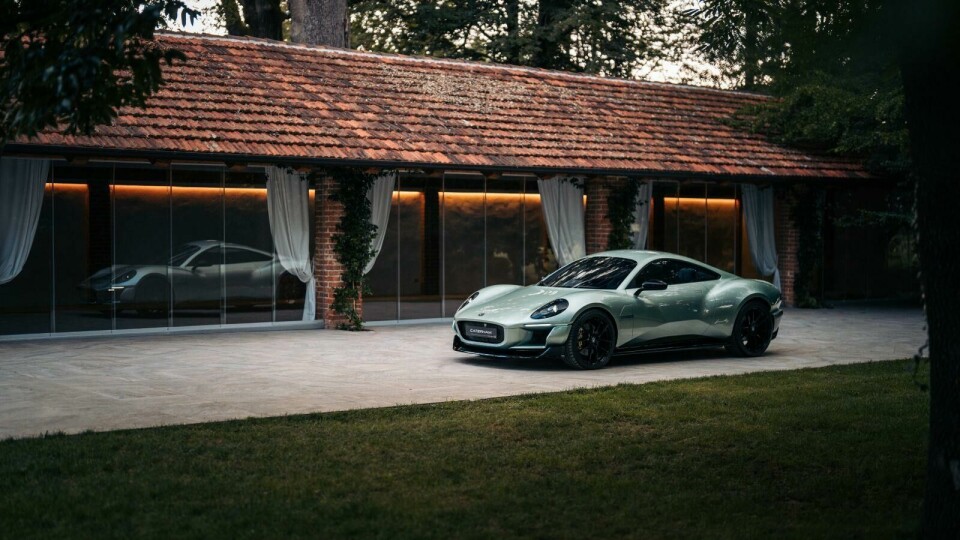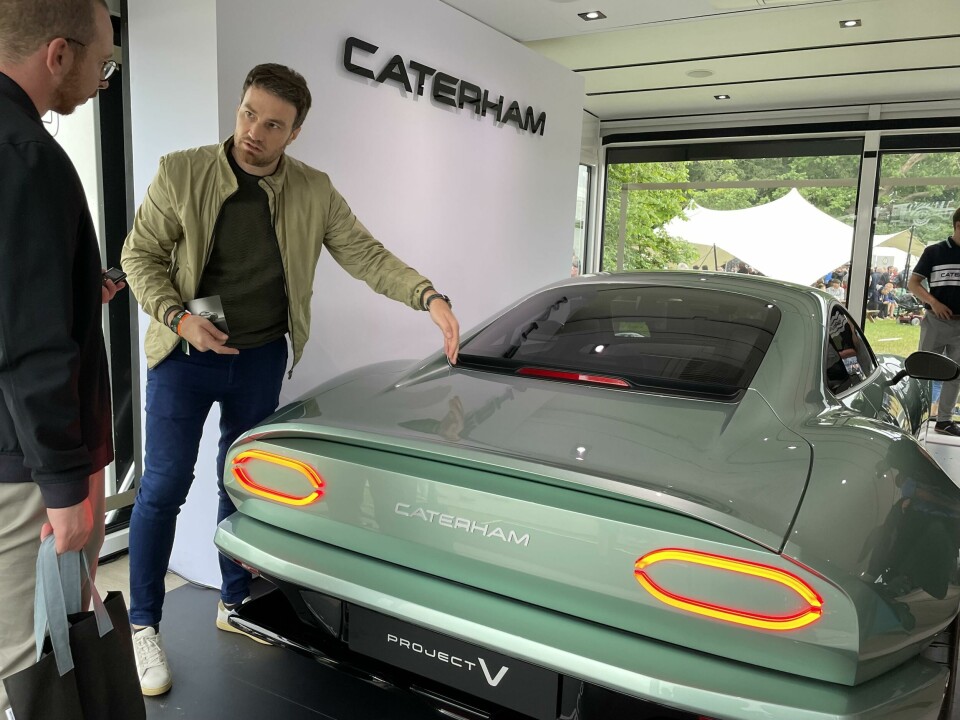
Caterham’s “retro-futurist” designer talks Project V and Italdesign collab
From owning a Caterham Seven and simply looking for a chance to visit Goodwood, Anthony Jannarelly ended up with a much better proposition: showcasing an all-new Caterham that he had designed from scratch in front of thousands of enthusiasts
Caterham is not a name that appears on Car Design News too frequently but many will be familiar with its iconic ‘Seven’ nameplate.
Now the brand is pushing into new territory to create a totally new kind of Caterham, one with a roof, a larger GT footprint and a sleek coupé silhouette. Revealed in the flesh at the Goodwood Festival of Speed, the Project V is a concept for now but very much with a production intent.
Lead designer Anthony Jannarelly was brought in following a chance encounter with Caterham’s owner, who explained his vision during a visit to Dubai. Jannarelly – a sportscar enthusiast who agonised over a Caterham Seven or a Porsche Speedster replica (eventually settling on the former) – leapt at the chance to get involved. Design house Italdesign was soon brought in to support the project and by all accounts it was a fruitful relationship.

The design story is fascinating, but first, some stats: 272PS from a 55kWh battery pack paired with a single motor mounted in the rear axle; 0-62mph in under 4.5 seconds; an estimated top speed of 143mph and a target WLTP range of 249 miles. We grabbed Jannarelly for a chat during the show to learn more about the car. (Editor’s note: we really had to get the elbows out for this one – the Project V had attracted quite the crowd.)
Car Design News: How did the project start?
Anthony Jannarelly: Bob [Laishley, CEO of Caterham Cars] and I met two years ago and he asked me if I’d like to design their next car. For me – owning a Caterham Seven myself – I understood the philosophy and you could say it was a natural brief for me. What was great is that it would be a brand-new car, with a brand-new chassis, built from the ground up to be an EV. And to be clear, a new company, Caterham Evo, was established to handle all relevant business and investment interests related to Project V. The original Seven will still be produced and will not be redesigned. This new product is about creating a small GT car.
The top surfacing is super clean, taking you back to the sixties with these flowing lines
CDN: How did your personal experience with the Seven influence the direction of this new project?
AJ: When I arrived in Dubai I wanted a vintage car with nice driving feel, and I was torn between a Caterham Seven or a Porsche 550 replica. I ended up buying a Seven, but a few years later I had the chance to drive a 550; it was really tough to drive. I thought the perfect car would have the feel of the Caterham and the design of the Porsche. I explained this to Bob and how we could retain the Caterham DNA with a glamorous shape. The top surfacing is super clean, almost taking you back to the sixties where you have these flowing lines. It is very feminine and sensual. We worked a lot on the reflections of the side profile in particular, spending hours with the team at Italdesign.
CDN: What was the exact brief for the Project V?
AJ: The brief was to go towards a GT car, but if we were to compete with the big OEMs we would need a really striking style. I spent a lot of time on the length of the car and the overall volume: if you make a small car, the issue is that it’s light and nimble but can run the risk of looking a bit ‘toyish’. I would say that it is best to think of this as the smallest GT on the market because you have space for the front passengers, you have space behind the front row for an extra seat, you have a huge luggage compartment at the back, and yet the car is only five centimetres longer than the Alpine [A110]. It’s even smaller than a Cayman or a Boxster.
CDN: It is small, but it looks like you’ve managed to make the most of that footprint. Could you explain the 2+1 configuration – a recognition that the 2+2 layout has never really worked?
AJ: My problem with the 2+2 is that you never put two adults in the back. And if you have a kid, they’re squashed behind the front seat. Those are the choices. But because the Project V is based on a skateboard platform you can carve out some space at the back and create this third seat in the middle. Whoever sits there has more space and will get a better view of the road.
CDN: Was there any pushback on the overall design given its contrast to the original Caterham Seven?
AJ: People were asking “how can we make sure it’s still a Caterham?” but the overall brief was to create a super simple, compact GT car. When you make things simple, you create a lighter car – so this naturally ties in with the Caterham spirit. Apple uses a process of elimination, and we tried to take a similar approach by minimising componentry, shut lines and no fancy decoration. The front is a big clam shell which does not open, for example, it’s only for servicing.
It was the perfect working relationship
I studied the Seven to find some stunning design cues in its architecture and saw that the car’s structure consists of three main arches – it’s almost like a generic sports car. If you ask a kid to draw a sports car, they would do two wheels and three sweeping lines – one above each wheel and one top line.
CDN: The gloss black side skirt – which is quite pronounced – sits in a similar way to the side-exit exhaust of the Caterham Seven. Was that a conscious decision or purely coincidence?
AJ: Honestly, I didn’t think about it in that way. For me it was the principle of having this dark area at the bottom – everybody uses this trick to make the car look lower to the ground.
CDN: How did the collaboration with Italdesign work out?
AJ: Honestly, it was the perfect working relationship. Their team has extensive knowledge, so many resources in-house, and we even did a feasibility study to ensure the windshield, mirror, lights – everything – is in the right position and able to be manufactured. As a designer it was so easy because they were able to check with their engineers and we had an answer the day after. Feedback was super quick, and I found this so helpful.
CDN: What was the development process like – was there a clay model?
AJ: No. It was only digital. I sketched and modelled the design in 3D and then worked daily with the guys from Italdesign to progress that. For me as a designer, what’s great is that you can really rely on them; they understand what you want. And if they feel something is not totally correct, we can have a discussion. I got the impression they were super motivated to work on this car as well.
CDN: It sounds like it was quite a fun project to work on.
AJ: It was, I felt very free and it was a great collaboration. I didn’t have ready to fight other designers or engineers for a specific area of the design. I could make everything harmonious and because Italdesign have all the necessary design departments they were always there to provide support. So the choice of colour, for example: I would orient that but then I would get the selection from Italdesign’s CMF team who proposed different choices and then you decide together. It was just perfect. I’m more of an exterior designer than an interior designer so I was happy to rely on their proposal.
CDN: How did you land on this particular shade of sage green?
AJ: I studied engineering so I like to apply logic before going into styling. If you don’t can’t decide on a colour, you go for grey, which can be great, but it’s neutral. Caterham is British and everyone thinks of British Racing Green, so we went for a desaturated green that is still kind of neutral but because it is metallic it accents shape of the car. Again, Italdesign understood this perfectly.
CDN: How does it feel seeing this on show here at Goodwood?
AJ: At first I was just trying to get to Goodwood, and now I’m here with a car I’ve designed. It’s amazing. I’ve heard people saying “hey, you should go and see this car” and our stand has been packed. Many people have told us it’s one of the best looking cars of the show. It’s a huge achievement for everyone involved.





































